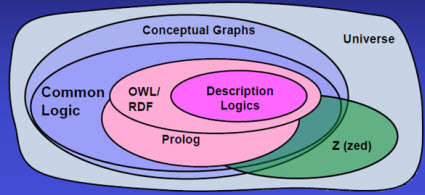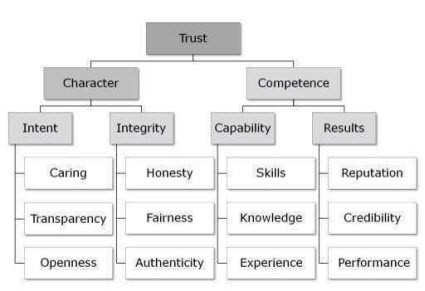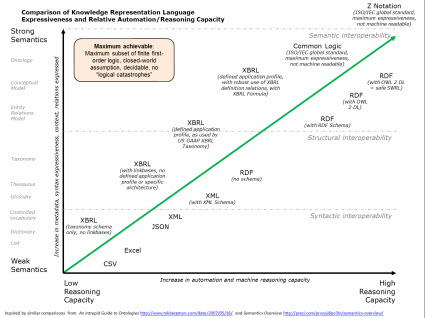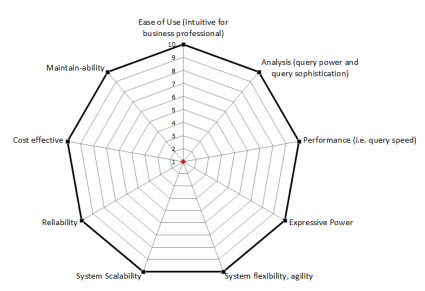BLOG: Digital Financial Reporting
This is a blog for information relating to digital financial reporting. This blog is basically my "lab notebook" for experimenting and learning about XBRL-based digital financial reporting. This is my brain storming platform. This is where I think out loud (i.e. publicly) about digital financial reporting. This information is for innovators and early adopters who are ushering in a new era of accounting, reporting, auditing, and analysis in a digital environment.
Much of the information contained in this blog is synthasized, summarized, condensed, better organized and articulated in my book XBRL for Dummies and in the chapters of Intelligent XBRL-based Digital Financial Reporting. If you have any questions, feel free to contact me.
Entries in General Information (257)
Properly Differentiating Data, Information, and Knowledge
The terms data, information, and knowledgeare easily confused. You can understand how to properly differentiate these terms by watching this 4 minute video by Nick Milton.
Knowledge is the piece of information that you need right now that allows you to take effective action. Actionable information.
Knowledge based systems provide capability and know how. Knowledge management is about creating a managed system that routinely and systematically institutionalizes knowledge and ensures that people have the knowledge they need to make correct decisions, take effective action, take the correct action.
The result of poor knowledge management are:
- Mistakes repeated
- Successful practices not replicated
- Slow rate of learning
- Knowledge lost when staff retires or gets a new job
We live in the information age, not the "data age". How do you turn data into information? How do you store information? How many mistakes does your organization repeat over and over? How are your processes for capturing good ideas and repeating them? How fast does your organization learn? How much knowledge will be lost when staff leave your organization?
Understanding Open Innovation
Are you an expert of the past? Or, do you anticipate the future? Technology disruption is part of every day life these days. Disruption is good for small companies because it is small companies that generally innovates best.
Open innovation is essentially inter-company cooperation in research and development. The term was promoted by Henry Chesbrough and is described in more detail as:
Open innovation is a paradigm that assumes that firms can and should use external ideas as well as internal ideas, and internal and external paths to market, as the firms look to advance their technology”. Alternatively, it is "innovating with partners by sharing risk and sharing reward." The boundaries between a firm and its environment have become more permeable; innovations can easily transfer inward and outward.
Open innovation is further explained in these videos:
- Open Innovation 02 - What is “open innovation"? (8 minutes)
- Three things I learned about disruptive innovation as an UberX driver, Ted Graham (10 minutes)
- TedTalk: Charles Leadbeater: The era of open innovation (20 minutes)
You want to be a disruptor. Disruptive innovation changes markets. The reward is highest where the uncertaintly and risk is the highest.
Don't listen to the experts of the past. If you want to disrupt the financial reporting market, here is informationthat will help you make sure you build the right products and solutions. Bolt-on solutions to existing inefficient processes is not innovation. Digital financial reporting will cause a transformation.
Creating High Performance Teams
In a video, The New Leadership Paradigm: An Interview with Richard Barrett, Richard Barrett explains that the essential ingredient of a high-performance team is trust. What is trust? The graphic below provides a breakdown of what creates trust. Before trust exists, certain other dependencies must also be present. The principal components of trust (the dependencies) are shown in the following diagram:
Being a high-performance team provides a competitive advantage. High-performance teams eliminate unnecessary or unproductive work that does not add value; enabling focus on necessary and productive work.
Balancing System Expressiveness and System Soundness
I have shown the graphic below before. The graphic summarizes the relative expressiveness and related relative reasoning capacity of various knowledge representation languages. I stole this idea from this blog post and this presentation which show the same information, I just organized some things slightly differently and added various XBRL implementation strategies: (see my original blog post here)
Here is another good graphic that compares relative expressiveness of different languages also:
 From Harry S. Delugach, Common Logic in Support of Metadata and Ontologies, bottom of page 2
From Harry S. Delugach, Common Logic in Support of Metadata and Ontologies, bottom of page 2
The vast majority of people are familiar with the level of expressiveness which can be achieved using relational databases. Experience with relational databases for past 25 years helps us undertand that. See my blog post Characterizing Truth: Semantics in Databases which explains the expressiveness which has generally been expressed within databases and specifically this graphic which tries to show limitations of databases.
But things are changing. Here are some changes that I see occurring:
- Richer information is being stored in databases: Contrast storing the information for an invoice in and accounting system with storing the information from an XBRL-based public company 10-K financial report. Both can be seen as transactions. But the relative richness of information in the financial report exceeds the relative richness of the information in the invoice. In the past, things like financial reports were not even structured. More and more information will be structured in the future.
- Business rules are moving from code to metadata: In the past, the information used to verify something like an invoice was stored in the code of an application, in the programming logic. That made it hard to add new rules or change rules because it took a programmer. This approach was costly and made such rules hard to maintain. Ronald G. Ross is the "father of business rules". Business rules are metadata which is properly separated from programming logic and maintained by business professionals.
- More business rules are necessary because information is richer: Because the richness of information is going up, the quantity of business rules that keep the quality of the information high also must also go up.
- More transactions and business rules are external to an organization: People could look at their systems as "silos" in the past. The Internet is changing that all that. Today sets of transactions can be shared between enterprises. Business rules are shared also. Think supply chain.
So those are the changes that are occurring. There are different camps of software vendors trying to provide products and solutions that address with these changes. There is the "semantic web" camp which seems to be pushing RDF/OWL and new types of databases such as triple stores and reasoners/inference engines and SPARQL queries. And you have your "NOSQL" camp that seems to be pushing NOSQL databases as the answer to these changes. And of course there are the entrenched incumbents, the relational database vendors, where a boatload of information is currently being stored, there is a heavy investment in such relational databases, and the relational database has morphed more than once in order to keep up with the changes that are occuring.
But I don't think anyone has pulled all the pieces together and gotten this right yet.
No one product/solution has put all the right pieces together and balanced the system correctly. For me, if the pieces are put together correctly you get an expert system. In this blog post I summarize the benefits offered by an expert system. Think "smart database".
Remember the Law of Conservation of Complexity and the notion of irreducible complexity. Remember that irreducible complexity is explained as follows:
A single system which is composed of several interacting parts that contribute to the basic function, and where the removal of any one of the parts causes the system to effectively cease functioning.
Partial solutions will not work. Complete solutions are necessary. What are the evaluation criteria which one should use to determine is some product or solution will fit your needs? Here are the general, high-level criteria as I see them:
It will be interesting to see what software vendors come up with. Balancing all these pieces and creating the proper equilibrium will be a valuable tool for business professionals.
Tableau Basics
If you have not tried Tableau, I would encourage you to do so. This is all you need to do:
- Download and install Tableau Public which is free.
- Watch this Overview of Tableau Video.
- Here is the data they used in the overview video related to Seattle building permits.
Good stuff!
ADDED: Here are some additional data sources:




